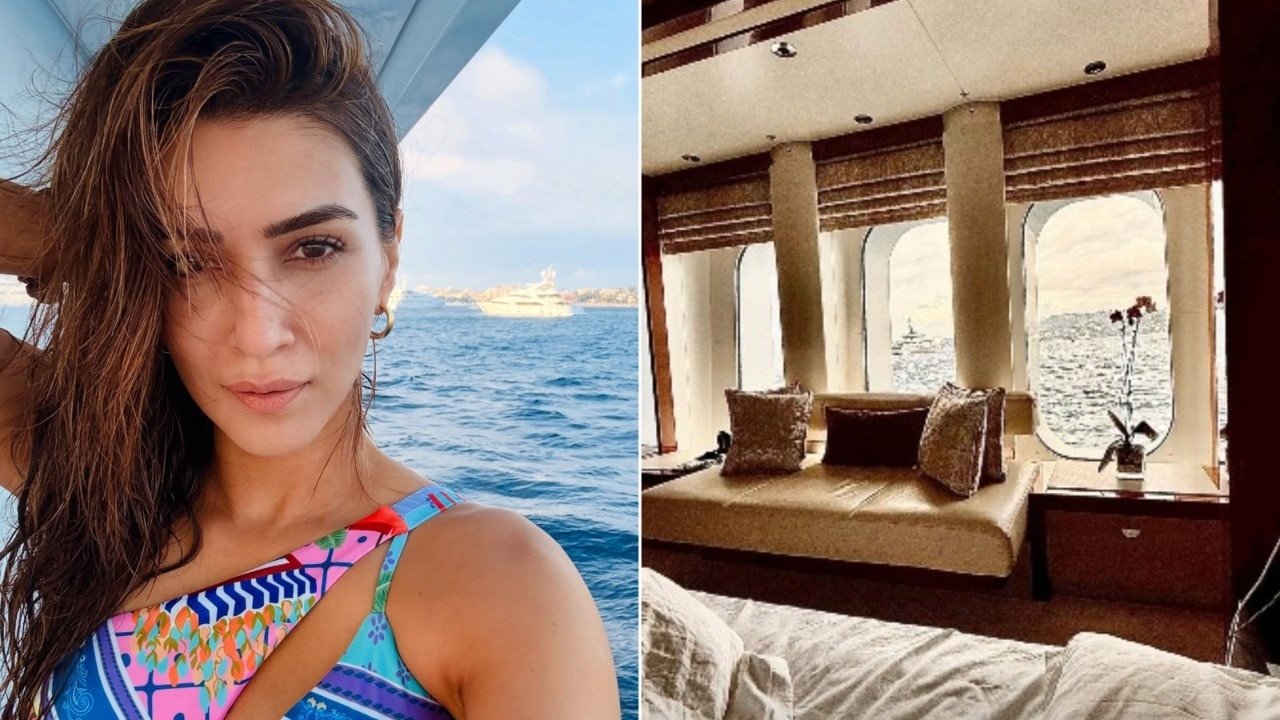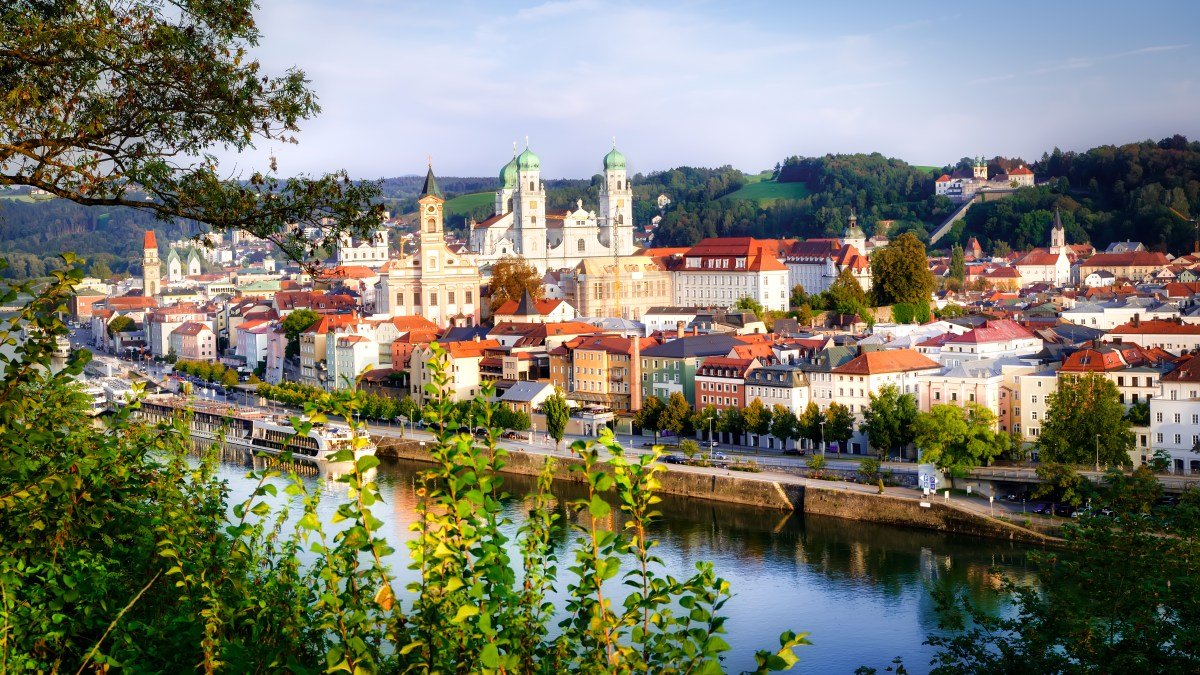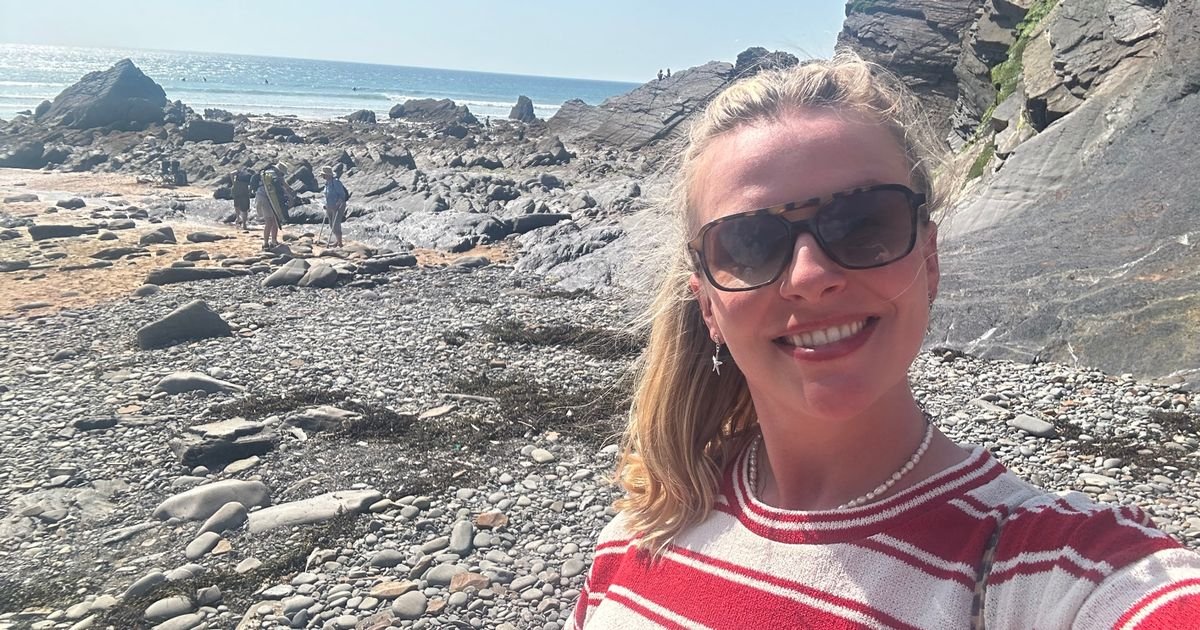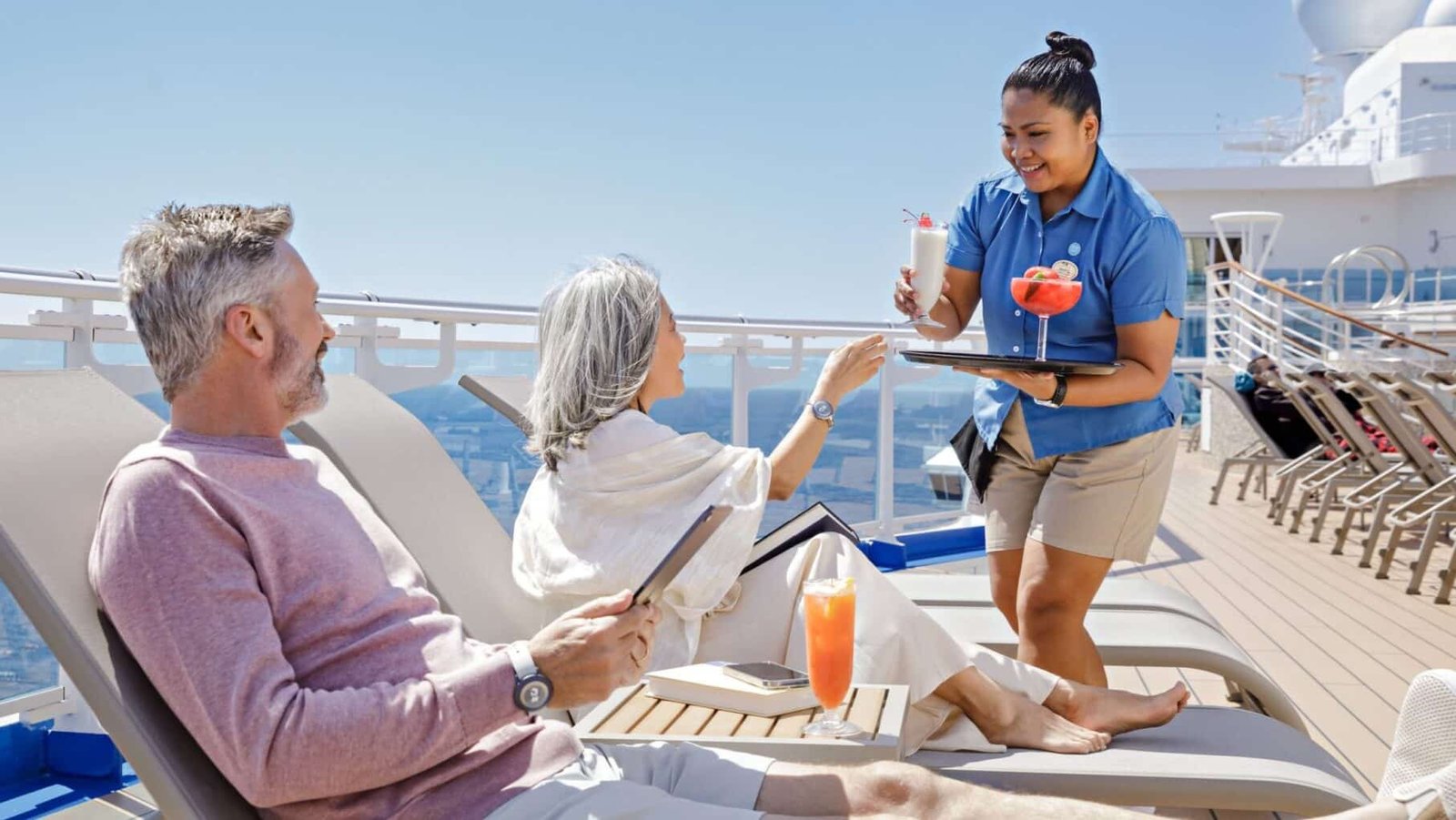There was nothing “express” about it though. Three slow laps of a circular track built into a man-made cave in Edwardian times, it chuffed out dry ice and tooted into the tunnel. Meanwhile, to the sides, a dozen tiny dioramas depicted frankly nightmarish scenes of grotesque dwarfs, giant grasshoppers and weird mushrooms inspired by Grimms’ fairytales.
My pal Mill and I have been friends since we studied music together at university and lived in a flatshare for several years in our twenties — an experience neither of us could have predicted would come in handy for sharing a cabin on a river cruise ship a quarter of a century later.
Laura, right, with her friend, Mill, outside the Grottenbahn in Linz
We’d been intending to take a trip for years, having seen each other grow across the decades via two marriages (me) and two sons (Mill). A seven-night Danube Waltz route through central Europe on the 190-passenger Viking Egil was spot-on, taking in places we’d studied during our degree: Bruckner’s Linz, Schönberg’s Vienna, Liszt’s Budapest. A cultural holiday through four countries sliding from genteel city to city but with enough home comforts to satisfy two always-on-the-brink-of-burnout fortysomethings. The toy railway set the tone early doors. Neither of us will regret skipping Linz’s fancy Ars Electronica Center in favour of howling until even our calves hurt on a novelty train.
Our cruise had started two days before in the Bavarian city of Passau — the first of six on the river route — reached by flying to Munich and transferring 90 minutes by road. Even though the city was nicknamed the Venice of Bavaria, my expectations for it weren’t high compared with those for other big hitters on the route, including Krems an der Donau, Vienna, Bratislava and Budapest. The day was grey and misty, with sombre bells pealing on Sunday morning from the city’s 53 churches, as we stepped out in our group of 15 or so, for the first of the daily walking tours included in the fare.
Our guide Ugar Yolci — who studied law at the University of Passau and was well versed in the city’s Napoleonic and gothic history — ricocheted us around the key sights with a sense of humour. We learnt about the colour coding of shop fronts from a time when few could read: pharmacies are green, bakeries pink and breweries yellow. We wandered down a narrow lane, Höllgasse, just off the Danube to see visible tide marks on the medieval buildings from floods that subsumed the city in 2013.
Laura travelled aboard the Viking Egil, which can carry up to 190 passengers
After the floods, many moved out of the city to the countryside. “The city centre is very affordable. You can get a flat for £780 a month and there’s a young and ambitious population here,” Yolci explained. “But what I love about living in Passau is how safe it is. Last summer I left my bike unlocked for days outside the train station and nobody stole it. It was old, I was hoping somebody would.”
On board Egil we easily got into a groove. We were up for breakfast at 7ish — part buffet with some à la carte options — and off the boat for a morning walking tour. Back for most lunches then afternoons exploring, or reading and lazing on the yacht-style Aquavit terrace at the stern. Our smart cabin on deck three also had a lounge area, big sliding doors facing the balcony and enough drawers and hangers for the incalculable volumes of Zara frocks we’d brought with us. The bathroom’s underfloor heating was a welcome upgrade on our student days.
• Discover our full guide to cruise holidays
In the airy restaurant, with communal tables of between six and eight, we could sit where and with whom we liked. The other passengers were mostly couples and mostly Americans, with a few Brits and Canadians in the mix and dinners made for lively conversation between Republicans and Democrats. We rotated around retired folk who worked in finance in Chicago, farmers from Wyoming and a multigen family from Illinois.
Meals like burgers and grilled salmon were always on the menu but, each evening, different local specialities peppered the selection according to the destination. There were marillenknodel (apricot dumplings) in Austria and halusky (savoury dumplings) in Slovakia. It all appeared like a really good neighbourhood bistro with regionally sourced ingredients and delicate presentations.
Evening entertainment was high quality too. At Linz a professional violin and piano duo from the Anton Bruckner Private University performed a set of Mozart and Elgar classics, while in Bratislava, local opera singers and musicians belted out Puccini to Bizet arias.
I barely felt the ship moving — at under ten years old it should be a smooth ride — but that’s important when you’re on a river that can twist and meander, especially through the Wachau valley. The most beautiful stretch was before Krems an der Donau, with sights like the baby-blue tower of Dürnstein Abbey unspooling on a perfectly sunny morning.
A trip to the baroque Göttweig Abbey is part of the itinerary
ALAMY
At Krems our first stop was Göttweig Abbey, a ten-minute coach ride south, dating from the 18th century after a fire destroyed the medieval original. We toured the magnificent baroque building with its frescoes designed to trick the eye. As this is a working monastery, we were graciously ushered from the ornate chapel at midday for prayers, leaving plenty of time to buy wines produced by the monks in the gift shop.
• More great Danube cruises
Which got us in the mood for that afternoon’s excursion to the winemaker Mörwald’s (from £90pp). Erhard Mörwald and the winery’s dirndl-donning guide Trinka Stumpfer were as sparky as their wines on board our ship: Mörwald and his family supply 100,000 bottles a year to Viking. They took eight of us on a tour around the vaulted brick cellars that Erhard built by hand. Billed as a wine tasting, it felt more like an all-dayer thanks to stealth pourings of grüner veltliner and schnapps. I left with yet another bottle of the region’s zweigelt in my rucksack.
One of the misunderstandings levelled at cruises is that you can’t get under the skin of a place in a day, but I’ve never found that to be true. While I’ve lost count of how many times I’ve visited Vienna on city breaks, I’d never cruised to the Austrian capital and this trip was an opportunity to see a part of town that was new to me, accompanied by a local expert. After docking at Handelskai, in the 20th district, we joined a private ebiking tour with Lucia Zakova, who guided us out beyond the city’s boundaries and into the countryside of Lower Austria (£147pp).
“It’s too early in the season to go to Donauinsel on the new Danube,” explains Zakova, about what is one of the city’s nudist river beaches, “so we’ll take a different route.” We chugged out to Klosterneuburg, a monastery on the edge of the Vienna Woods, for a glorious three-hour round trip with the winsome moss-green Danube always to our side. The brand new bikes, more powerful on Vienna’s hills than my car, made it easy.
The cruise also includes a two-night dock in Budapest
GETTY IMAGES
A two-night stop in Budapest marked the end of the trip. This was the appeal of Viking’s west-to-east Danube route, as it finished in a city new to us both. One benefit of staying on a river ship was not having to choose between hilly Buda or flatter Pest because Egil docked slap between the two, underneath the Szechenyi chain bridge.
On the first morning we joined the group tour, for a whizz around the city via coach to the gold-frescoed joy of Matthias Church. Then Mill and I made our own musical pilgrimage, walking from the dock through the city centre, past the synagogue, to the Franz Liszt Memorial Museum, dedicated to the 19th-century composer famed for his solo piano works. The tiny, two-room museum is in Liszt’s old flat where he lived in the 1880s, on the first floor of Budapest’s former academy of music. Despite being a committed Roman Catholic, Franz was an absolute hound who never married, instead having two long-term romances. His daughter Cosima went on to marry Richard Wagner.
• The best river cruises for solo travellers
Liszt’s collection of grand pianos, housed in a small space, is impressive and includes a fine walnut “composing desk” — a table with a nifty pull-out three octave piano tucked inside — built for him by his friend Ludwig Bösendorfer, a sort of 19th-century Elon Musk. Even if romantic piano works aren’t your bag, the elegant original bookcases from Liszt’s time and Thonet chairs are worth a detour (£8; lisztmuseum.hu).
Our final morning, a Saturday, brought torrential rain. From the window of our cabin we could see the tempting Gellert Thermal Baths and we made a run for it, drenched before we’ve even got in the 36C pool.
Take a relaxing dip in the beautiful Gellert Thermal Baths
SHUTTERSTOCK
Inside, the baths were more beautiful than myriad Instagram posts could ever render, with church-like vaulted ceilings, stained glass and original colourful tiles as we flitted about from pools to saunas and steam rooms. We’d both booked Aroma massages as a treat. It was the opposite of relaxing. We spent about 20 minutes being slapped about by a Hungarian woman in a room that looks like a dental surgery but it did push out lingering knots (massage £23, entrance £23; gellertbath.hu).
• Best Rhine river cruises
While this trip served up lots of intellectually serious moments (classical music performances, Jewish history and quirky museums) it also brought what we both needed so badly: a lot of impromptu laughs at some of central Europe’s most joyously unexpected experiences.
Laura Jackson was a guest of Viking, which has seven nights’ full board from £1,695pp on a Danube Waltz itinerary, including flights, departing on November 22, 2026 (viking.com)



























You must be logged in to post a comment Login